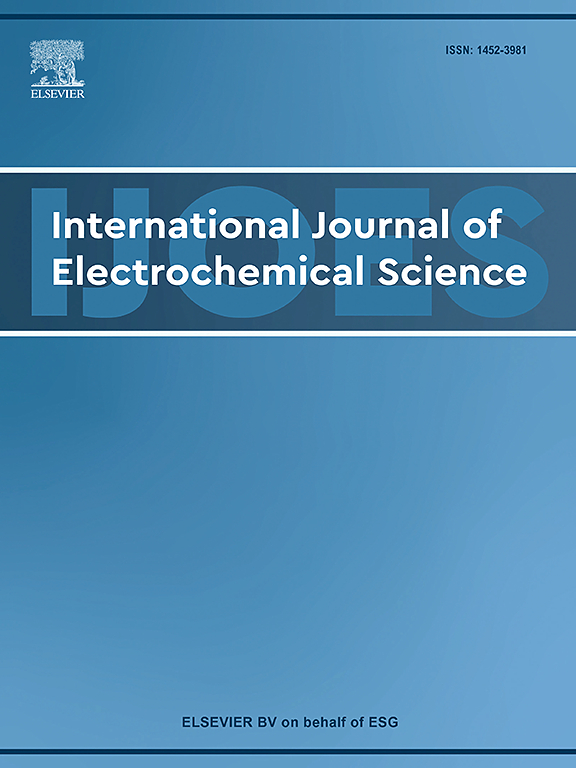Corrosion behavior of electrodeposited Zn–Co and Zn–Co–Mo coatings on mild steel in NaCl solution
IF 2.4
4区 化学
Q4 ELECTROCHEMISTRY
International Journal of Electrochemical Science
Pub Date : 2025-10-14
DOI:10.1016/j.ijoes.2025.101208
引用次数: 0
Abstract
Vehicle body, particularly against chloride-containing environments such as de-icing salts, is a challenging task. The Zn-Co films are a potential and promising one for coated steel sheets, but a third alloying element in the Zn-Co alloys such as molybdenum greatly improves the performance of anticorrosive properties. In this study, the corrosion behavior and surface morphology of electrodeposited binary Zn-Co and ternary Zn-Co-Mo coatings on mild steel were examined. Coatings were electrodeposited from an acidic chloride solution containing sulphanilic acid (brightener) and gelatin (grain refiner). The chemical component of the coatings was verified by ICP-OES and EDS. Corrosion resistance was tested in 3.5 wt% NaCl solutions by potentiodynamic polarization and electrochemical impedance spectroscopy (EIS). The surface morphology and chemical composition were characterized using scanning electron microscopy (SEM), Energy-dispersive X-ray spectroscopy (EDS), and X-ray photoelectron spectroscopy (XPS). Results revealed that 1.7 wt% cobalt showed the highest improvement in binary alloy. The incorporation of molybdenum (∼ 1.0 wt%) resulted in a smoother, more uniform, and finer-grained ternary coating. Electrochemical studies resulted in noteworthy decrease in corrosion current density and increase charge transfer resistance for Zn-Co-Mo. The XPS analysis also evidences the presence of stable, molybdenum-enriched passive oxide layers which block chloride ion ingress. The ternary Zn-Co-Mo coating (containing 1.7 wt% Co and 1.0 wt% Mo) shows excellent corrosion resistance in chloride environment by the creation of a dense and stable passive film, as it finds potential application for corrosion protection of car parts in automotive industry.
电沉积Zn-Co和Zn-Co - mo涂层对低碳钢在NaCl溶液中的腐蚀行为
汽车车身,特别是对含氯环境,如除冰盐,是一个具有挑战性的任务。Zn-Co薄膜是一种很有潜力和前景的涂覆钢板薄膜,但Zn-Co合金中的第三种合金元素(如钼)大大提高了镀层的防腐性能。研究了电沉积Zn-Co二元镀层和Zn-Co- mo三元镀层在低碳钢上的腐蚀行为和表面形貌。涂料由含有磺胺酸(增白剂)和明胶(晶粒细化剂)的酸性氯化物溶液电沉积而成。用ICP-OES和EDS对涂层的化学成分进行了表征。采用动电位极化和电化学阻抗谱(EIS)测试了其在3.5 wt% NaCl溶液中的耐蚀性。利用扫描电镜(SEM)、x射线能谱(EDS)和x射线光电子能谱(XPS)对其表面形貌和化学成分进行了表征。结果表明,1.7 wt%的钴对二元合金的改善最大。钼(~ 1.0 wt%)的加入使三元镀层更光滑、更均匀、晶粒更细。电化学研究结果表明,Zn-Co-Mo的腐蚀电流密度显著降低,电荷转移电阻显著增加。XPS分析也证明了稳定的、富钼的被动氧化层的存在,这阻止了氯离子的进入。三元Zn-Co-Mo涂层(含1.7 wt% Co和1.0 wt% Mo)通过形成致密稳定的钝化膜,在氯化物环境中具有优异的耐腐蚀性,在汽车工业中具有潜在的汽车零部件防腐应用前景。
本文章由计算机程序翻译,如有差异,请以英文原文为准。
求助全文
约1分钟内获得全文
求助全文
来源期刊
CiteScore
3.00
自引率
20.00%
发文量
714
审稿时长
2.6 months
期刊介绍:
International Journal of Electrochemical Science is a peer-reviewed, open access journal that publishes original research articles, short communications as well as review articles in all areas of electrochemistry: Scope - Theoretical and Computational Electrochemistry - Processes on Electrodes - Electroanalytical Chemistry and Sensor Science - Corrosion - Electrochemical Energy Conversion and Storage - Electrochemical Engineering - Coatings - Electrochemical Synthesis - Bioelectrochemistry - Molecular Electrochemistry

 求助内容:
求助内容: 应助结果提醒方式:
应助结果提醒方式:


